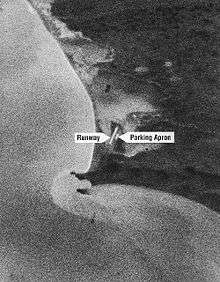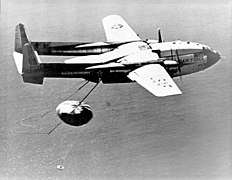Discoverer 14
Discoverer 14 (also known as KH-1 9009) was a spy satellite used in the Corona program managed by Advanced Research Projects Agency (ARPA) of the Department of Defense and the United States Air Force. On 19 August 1960, usable photographic film images of the Soviet Union taken by the satellite were recovered by a C-119 recovery aircraft. This was the first successful recovery of film from an orbiting satellite and the first mid-air recovery of an object returning from Earth orbit.[1]


The primary goal of the DISCOVERER program was to develop a film-return photographic surveillance satellite to assess how rapidly the Soviet Union was producing long-range bombers and ballistic missiles and where they were being deployed and to take photos over the Sino-Soviet bloc to replace the U2 spyplanes. It was part of the secret CORONA program which was also used to produce maps and charts for the Department of Defense and other US government mapping programs. The goal of the program was not revealed to the public at the time, it was presented as a program to orbit large satellites to test satellite subsystems and investigate the communication and environmental aspects of placing humans in space, including carrying biological packages for return to Earth from orbit. In all, 38 Discoverer satellites were launched by February 1962, although the satellite reconnaissance program continued until 1972 as the CORONA project. The program documents were declassified in 1995.[1]
DISCOVERER 14 was the first successful low-resolution photo surveillance spacecraft, 860 kilograms (1,900 lb), launched by the US Air Force. It was launched into a polar orbit by a Thor-Agena A booster on 18 August 1960 at 19:55:00 GMT from Vandenberg AFB. After the Thor exhausted its fuel, the Agena A vehicle atop the Thor separated from it. The Agena's main engine then ignited, increasing the satellite's top speed to 28,417 kilometres (17,658 mi), thereby achieving an orbit of 186 kilometres (116 mi) above the Earth at the low point and 805 kilometres (500 mi) at the high point, with a period of 94.55 minutes and an inclination of 79.65°. On 19 August 1960, over Alaska on the 17th pass around the Earth, the Agena ejected DISCOVERER 14 from its nose and retrorockets attached to the satellite recovery vehicle (SRV) fired to slow it for the return from orbit. After DISCOVERER 14 reentered the atmosphere, it released a parachute and floated earthward. The descending parachute was sighted 360 miles southwest of Honolulu, Hawaii, by the crew of a US Air Force C-119 recovery aircraft from the 6593rd Test Squadron based at Hickham AFB, Hawaii. On the C-119's third pass over the parachute, at about 2,438 metres (7,999 ft) altitude, the recovery gear trailing behind the aircraft successfully snagged the parachute canopy. A winch operator aboard the C-119 then reeled in the satellite recovery vehicle (SRV) after its 27-hour, 725,000 kilometres (450,000 mi) journey through space. This was the first successful recovery of film from an orbiting satellite and the first aerial recovery of an object returning from Earth orbit. DISCOVERER 14 disintegrates on 16 September 1960.[1]
DISCOVERER 14 was launched on 18 August 1960, one week after the successful water recovery of the DISCOVERER 13 capsule. The vehicle carried a camera and a 9 kg load of film. The camera operated satisfactorily, and the full load of film was exposed and transferred to the recovery capsule. The Agena did not initially position itself in orbit so as to permit the recovery sequence to occur. It was on the verge of tumbling during the first few orbits, and an excessive quantity of gas had to be used in correcting the situation. Fortunately, vehicle attitude became stabilized about midway through the scheduled flight period, thus relieving the earlier fear that recovery would be impossible. The satellite recovery vehicle (SRV) was ejected on the 17th pass, and the film capsule was recovered by air snatch. Captain Harold E. Mitchell of the 6593rd Test Squadron, piloting a Fairchild C-119 Flying Boxcar, called Pelican 9, successfully hooked the descending capsule on his third pass.[2]
References
- "NASA - NSSDCA - Spacecraft - Details". nssdc.gsfc.nasa.gov. Retrieved 25 January 2020.

- "Corona: America's First Satellite Program" (PDF). Central Intelligence Agency. 1995. p. 22. Retrieved 25 January 2020.
